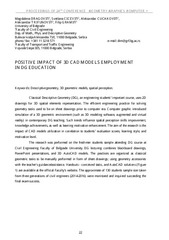Prikaz osnovnih podataka o dokumentu
Positive impact of 3D CAD models employment in DG education
| dc.creator | Dragović, Magdalena | |
| dc.creator | Čičević, Svetlana | |
| dc.creator | Čučaković, Aleksandar | |
| dc.creator | Trifunović, Aleksandar | |
| dc.creator | Gramić, Filip | |
| dc.date.accessioned | 2019-04-30T13:23:48Z | |
| dc.date.available | 2019-04-30T13:23:48Z | |
| dc.date.issued | 2017 | |
| dc.identifier.uri | https://grafar.grf.bg.ac.rs/handle/123456789/1543 | |
| dc.description.abstract | Classical Descriptive Geometry (DG), an engineering students' important course, uses 2D drawings for 3D spatial elements representation. The efficient engineering practice for solving geometry tasks used to be on sheet drawings prior to computer era. Computer graphic introduced simulation of a 3D geometric environment (such as 3D modeling software, augmented and virtual reality) in contemporary DG teaching. Such trends influence spatial perception skills improvement, knowledge achievements, as well as learning motivation enhancement. The aim of the research is the impact of CAD models utilization in correlation to students evaluation scores, learning style, and motivation level. The research was performed on the freshmen students sample attending DG course at Civil Engineering Faculty of Belgrade University. DG lecturing combines blackboard drawings, PowerPoint presentations, and 3D AutoCAD models. The practices are organized as classical geometric tasks to be manually performed in form of sheet drawings; using geometry accessories with the teacher's guidance/assistance. Handouts - conceived tasks, and AutoCAD solutions (Figure 1) are available at the official Faculty's website. The approximate of 130 students sample size taken from three generations of civil engineers (2014-2016) were monitored and inquired succeeding the final exam success. Paper based questionnaire (constructed by the authors for the purpose of this study) was employed. Data entries from Microsoft Excel spreadsheet were imported into IBM SPSS Statistics base. Frequency histograms and the Kolmogorov-Smirnov Test were used to determine whether the mean scores obtained during testing had a normal distribution. Since the distribution of all interval variables significantly deviated from the normal distribution, the nonparametric Mann-Whitneys rank sum test was imployed. The results have shown significant contribution after 3D models assistance introduction in DG teaching/learning process, regarding students' motivation level and success evaluation. | en |
| dc.publisher | Silesian University of Technology- Geometry and Engineering Graphic Centre, Gliwice | |
| dc.rights | openAccess | |
| dc.rights.uri | https://creativecommons.org/licenses/by-nc-nd/4.0/ | |
| dc.source | Proceedings of 24th Conference Geometry, Graphics, Computer | en |
| dc.title | Positive impact of 3D CAD models employment in DG education | en |
| dc.type | conferenceObject | |
| dc.rights.license | BY-NC-ND | |
| dc.citation.epage | 23 | |
| dc.citation.other | : 22-23 | |
| dc.citation.spage | 22 | |
| dc.identifier.fulltext | https://grafar.grf.bg.ac.rs//bitstream/id/3564/1541.pdf | |
| dc.identifier.rcub | https://hdl.handle.net/21.15107/rcub_grafar_1543 | |
| dc.type.version | publishedVersion |

